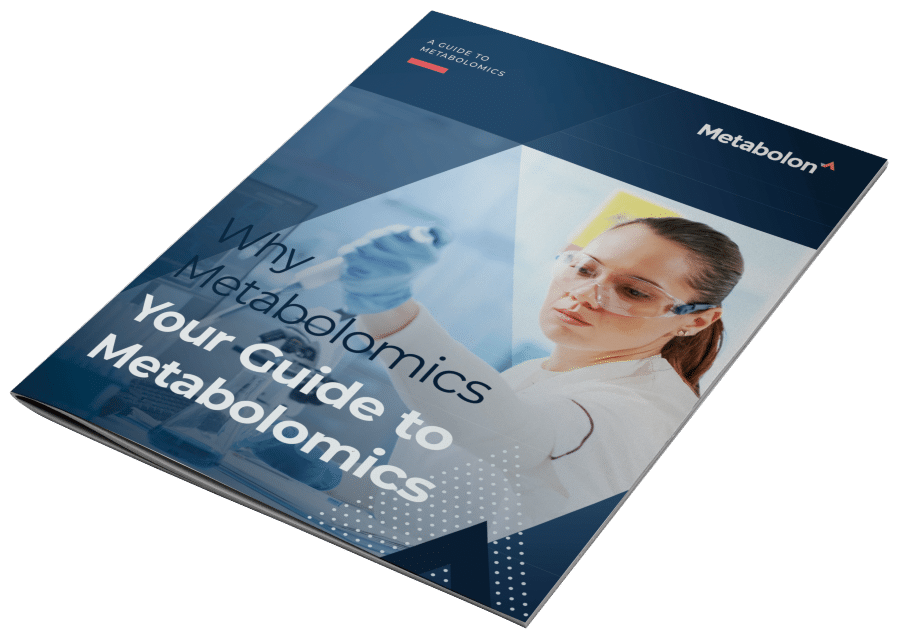Chapter 3—Metabolite Identification and Detection
If you’ve studied the first two chapters of this comprehensive guide on metabolomics, you have a basic idea of what metabolomics is and how it fits into the greater omics landscape. In this chapter, we’ll take a deeper dive into metabolomics, including the types of metabolomics-based analyses that you can do and what they tell you about the metabolic processes occurring in a biological host or environment.
What is Metabolomics?
As discussed in previous chapters, metabolomics is the identification and quantification of small molecules known as metabolites. Because these small molecules are necessary for cell growth, defense, inhibition, and stimulation—and because their function can be significantly impacted by a range of factors such as age, disease, drugs, and the environment—studying them is a powerful tool for understanding biological function.
Metabolites are sensitive to a range of different factors, making the metabolome a fluid entity. Therefore, metabolomics, which can characterize these dynamic molecular changes, can be thought of as longitudinal phenotyping or a “study in motion.” This makes metabolomics a particularly powerful tool for time series studies, such as responses to therapeutic regimens. Clinical applications such as this will be discussed thoroughly in Chapter 5—Clinical Applications of Metabolomics.
It is important to recognize that the metabolome includes not just metabolites produced by the organism itself (such as amino acids, alcohols, and vitamins), but also exogenous metabolites1 from the environment, including food, medication, or environmental toxins. A large proportion of studies also investigate the metabolome of the microbiome and how it, too, interacts with the host and environmental metabolomes to impact disease pathogenesis, drug response, nutrient acquisition, and more.
The Metabolome and Metabolic Reactions
Metabolomics-based analyses are nothing more than an observation of metabolic reactions within the host. Metabolites are the end products of those reactions, and identifying and quantifying them, especially over time, provides a good window into the biological function of the host under a defined set of conditions.
But what, exactly, do we mean when we say metabolic reactions? Simply put, metabolic reactions are chemical reactions required to sustain life. There are two basic types of metabolic reactions: catabolic, making energy from breaking down nutrients, and anabolic, building compounds. Some examples of metabolic reactions are:
- Carbohydrates from foods are turned into glucose, which is then used to generate ATP (adenosine triphosphate, the energy currency of the cell).
- Drugs are broken down by the body into forms that are more easily excreted.
- Amino acids combine and form proteins, which have thousands of different forms and functions in the human body.
- Bacteria in the large intestine break down fiber into molecules called short-chain fatty acids, which then act as a source of energy for intestinal cells.
By sampling the metabolome frequently over a period of time, researchers can begin to understand how and why certain metabolic changes and patterns regulate or inform the development of disease, the efficacy of drugs, and other physiological processes. For example, researchers have found biomarkers that can inform certain cancers, and, going deeper, other biomarkers that can diagnose and prognosticate other cancers.2,3 In some cases, the mechanism of action behind these different metabolite populations has been elucidated and can include molecular events such as altered gene expression, alternative splicing events, or impaired cellular processes.
Profiling Metabolomes
Mass spectrometry (MS) and nuclear magnetic resonance (NMR)-based techniques are most commonly used to capture and analyze metabolomes.4 In cases where investigators want to identify the metabolites in a set of samples, we use a global untargeted approach. When the aim is to quantify a set of known metabolites (such as in drug metabolism studies), we use targeted metabolomics. Untargeted metabolomics is used to generate hypotheses while targeted metabolomics is used to test hypotheses and better understand the findings of untargeted studies.
A wide range of sample types can be used for metabolomics analyses, including cells in culture or culture media, tissue, feces, blood, urine, and sweat. The sample source you use depends on what you’d like to study; for example, you’ll select feces if you want to study microbial impacts on host nutrient acquisition, but tissue samples if you want to identify biomarkers that differentiate primary tumors and metastases. Samples must be carefully prepared according to the amount and type of sample and whether a targeted or untargeted approach is desired. Sample preparation will be discussed in greater detail in Chapter 9—Designing a Metabolomic Study.
What’s Next?
Now that you have a better understanding of how metabolites are detected, we’ll use the following chapters to get into the meat of metabolomics studies: why they are important, how these studies can be applied to clinical, academic, and commercial projects, and how to design your own metabolomics study. We’ll start the rest of our journey in Chapter 4 with an in-depth discussion on the importance of metabolomics insights.

Continue to Chapter 4 - The Importance of Metabolomics Insights
In the next chapter, we’ll discuss why metabolomics is an attractive option on many levels, and provide a brief introduction to the academic, clinical, and commercial applications of metabolomics studies.
References
- Liu X, Locasale JW. Metabolomics: A Primer. Trends Biochem Sci. 2017;42(4):274-284. doi:10.1016/j.tibs.2017.01.004
- Perkins BA, Caskey CT, Brar P, et al. Precision medicine screening using whole-genome sequencing and advanced imaging to identify disease risk in adults. Proc Natl Acad Sci U S A. 2018;115(14):3686-3691. doi:10.1073/pnas.1706096114
- Shen J, Ye Y, Chang DW, et al. Circulating metabolite profiles to predict overall survival in advanced non-small cell lung cancer patients receiving first-line chemotherapy. Lung Cancer. 2017;114:70-78. doi:10.1016/j.lungcan.2017.10.018
- Ashrafian H, Sounderajah V, Glen R, et al. Metabolomics: The Stethoscope for the Twenty-First Century. Med Princ Pract. 2021;30(4):301-310. doi:10.1159/000513545
Table of Contents
Chapter 1 — Metabolomics, Metabolites, and the Metabolome
Chapter 2 — Other Omics Sciences and Metabolomics
Chapter 3 — Metabolite Identification and Detection
Chapter 4 — The Importance of Metabolomics Insights
Chapter 5 — Clinical Applications of Metabolomics
Chapter 6 — Academic Applications of Metabolomics
Chapter 7 — Commercial Applications of Metabolomics
Chapter 8 — Regulatory Applications of Metabolomics
Download guide as PDF
Share this chapter
See how Metabolon can advance your path to preclinical and clinical insights
Contact Us
Talk with an expert
Request a quote for our services, get more information on sample types and handling procedures, request a letter of support, or submit a question about how metabolomics can advance your research.
Corporate Headquarters
617 Davis Drive, Suite 100
Morrisville, NC 27560
Mailing Address:
P.O. Box 110407
Research Triangle Park, NC 27709

